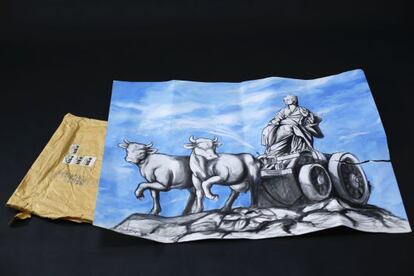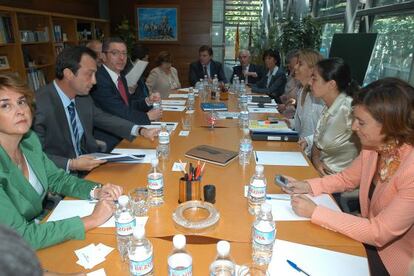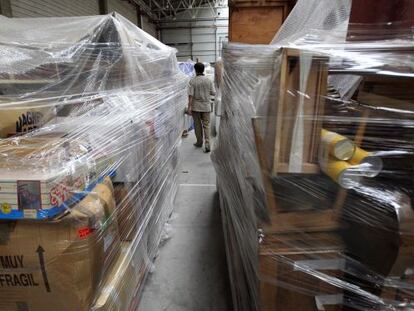Mystery deepens, as Madrid council’s missing painting mailed to EL PAÍS
Damaged work turns up in envelope with letter offering explanation for disappearance

A painting that went missing from a Madrid city council office has been mailed anonymously to EL PAÍS, two weeks after the newspaper reported its disappearance.
The revelations about the painting by Antonio de Felipe, whose work hangs in the Reina Sofía contemporary art museum, caused commotion within the Madrid branch of the Popular Party (PP), which has been in power in the capital since 1991. Mayor Ana Botella ordered an official investigation into the case, while former Madrid premier Esperanza Aguirre, who still heads the regional branch of the party, began an internal investigation.
On Tuesday, a large envelope with no return address showed up at the EL PAÍS newsroom. Inside, wrinkled and visibly damaged, was the Cibeles láctea, a 75x96cm acrylic depiction of the Cibeles fountain, an iconic city landmark. In the painting, the chariot of the statue is being pulled by cows instead of lions. Painted in 1996, the work is worth an estimated 12,000 euros.
The painting came with an anonymous letter explaining how it came to disappear, and pointing the finger of blame at a city worker in the Retiro district council, where the painting was last seen hanging. But nearly all of the individuals with a connection to the incident who were consulted by EL PAÍS doubt the truthfulness of the letter's claims.
Antonio de Felipe, an artist from Valencia, left the painting in the care of city authorities in September 1996, following an exhibition at the cultural center Casa de Vacas, located in the Retiro district. De Felipe notes that back then, when artists had their work shown at city-owned galleries, it was mandatory to leave one artwork behind to beef up the municipal holdings. The artist has confirmed that the painting that showed up at EL PAÍS is the same one he left the city in 1996, after the Casa de Vacas show.

For a while, the painting hung inside the office of Francisco Javier Ramírez Caro, who was appointed director of Casa de Vacas in 1998. But he left the city council in July 2005 over differences with the Retiro district councilor, Elena González Moñux.
“When the councilor showed up, she saw the painting and asked to have it for her own office. And there it was when I left the city council," says Ramírez. A photograph distributed by local authorities in May 2006 shows Cibeles láctea still hanging in the councilor's meeting room. Moñux headed the Retiro district until 2007, when she was transferred to Fuencarral-El Pardo.
Sources close to Aguirre say that the former regional premier has been personally making phone calls to try to unravel the mystery. Aides also claim that Aguirre is keen to avoid any more corruption scandals, after it emerged that some of her people were involved in Gürtel, the widespread kickbacks-for-contracts case that is affecting the PP at a national level.
The trail of the painting was lost in 2007. The councilor who took over from Moñux at the Retiro district, Luis Asúa, says that he never saw it because his predecessor took it away with her when she moved to Fuencarral-El Pardo. He adds that several municipal workers can attest to this fact.
According to the letter sent to EL PAÍS, "when Mr Asúa showed up as the new councilor of the Retiro district, he ordered the painting taken down because he said it was ‘F***ing ugly,’ although I did not hear that myself. And so it was sent back to Casa de Vacas. There it was for quite a while, without anyone claiming it back, among the crates and things from various exhibitions. Then, a few years ago, during a refurbishment at Casa de Vacas that I was overseeing, I saw the painting practically sitting among the things to be thrown out, still in the same bubble wrap, and I just naturally picked it up and took it home. Please permit me to withhold my name, for obvious reasons. I am a city worker. Thank you, and sorry for the inconvenience."
But Asúa denies having ordered the painting taken down, and several sources noted that art holdings are not kept at Casa de Vacas but at the Retiro district council. Also, municipal sources said that there was indeed one major renovation project at Casa de Vacas, but it was in July 2006, under Moñux, not Asúa.
Moñux told EL PAÍS that she was "surprised" at the turn of events. "I've had a hard time of it because I've been accused of taking it," she said. "I never liked it; my conscience is clear."
The painting was one of around 200 artworks and artifacts reported missing by EL PAÍS from a catalogue of city-owned goods.
Tu suscripción se está usando en otro dispositivo
¿Quieres añadir otro usuario a tu suscripción?
Si continúas leyendo en este dispositivo, no se podrá leer en el otro.
FlechaTu suscripción se está usando en otro dispositivo y solo puedes acceder a EL PAÍS desde un dispositivo a la vez.
Si quieres compartir tu cuenta, cambia tu suscripción a la modalidad Premium, así podrás añadir otro usuario. Cada uno accederá con su propia cuenta de email, lo que os permitirá personalizar vuestra experiencia en EL PAÍS.
¿Tienes una suscripción de empresa? Accede aquí para contratar más cuentas.
En el caso de no saber quién está usando tu cuenta, te recomendamos cambiar tu contraseña aquí.
Si decides continuar compartiendo tu cuenta, este mensaje se mostrará en tu dispositivo y en el de la otra persona que está usando tu cuenta de forma indefinida, afectando a tu experiencia de lectura. Puedes consultar aquí los términos y condiciones de la suscripción digital.









































